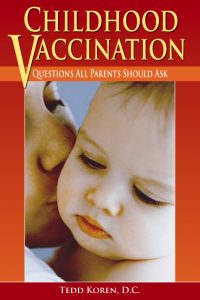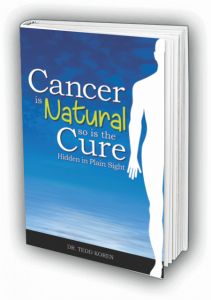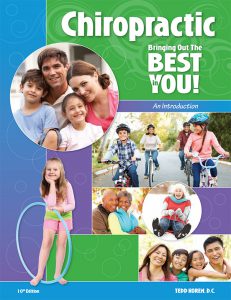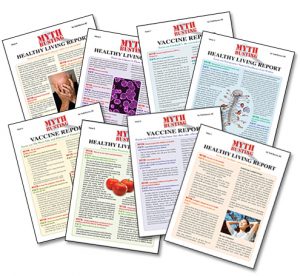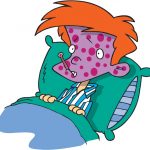My Brother’s Asthma Attacks
I remember it well. The heavy wheezing, laboring for every breath, concerned voices, phone calls in the middle of the night, rushing to the hospital. My youngest brother, David, was having an asthma attack. My parents returned home with him after he got emergency medications.
Few people had asthma then, but that was changing. Soon millions of families would experience that terror. According to WHO (World Health Organization) estimates, 235 million people suffer from asthma and the numbers continue to rise.
http://www.who.int/respiratory/asthma/en/ Retrieved 08/21/2017.
But we didn’t only give David drugs. My father had a dry-cleaning store in Brooklyn and became friends with Herbie, one of his customers. Herbie was a Palmer graduate. One night Herbie carried a piece of luggage up our apartment steps, opened it and unfolded a little table in our living room. David got his first chiropractic adjustment. It seemed to make a difference; David’s asthma attacks began to abate.
But let’s backtrack a bit. What is asthma? To understand that we need to know a little bit about breathing.
Raw Air
“Raw air” is too cold, dry and dirty to use immediately in your body. After inhaling it gets filtered, warmed, cleansed and humidified in your nose and nasal cavities before it goes down your trachea or “windpipe.” The trachea is a tube in your throat surrounded 15-20 stiff rings of cartilage (so that it’ll never close and suffocate you). It’s easy to feel – place your fingers under your Adam’s apple and you can feel the rings.
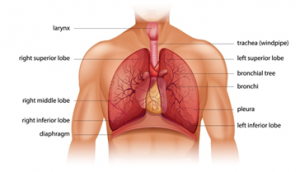 Your trachea travels into your chest and divides into left and right branches called bronchi. The bronchi enter your lungs and branch over and over to form tiny branches. The tiniest ones are called bronchioles and these actually touch the lungs. At the tip of these tiny bronchioles the magic of respiration occurs – oxygen enters your blood and carbon dioxide and water vapor leave it.
Your trachea travels into your chest and divides into left and right branches called bronchi. The bronchi enter your lungs and branch over and over to form tiny branches. The tiniest ones are called bronchioles and these actually touch the lungs. At the tip of these tiny bronchioles the magic of respiration occurs – oxygen enters your blood and carbon dioxide and water vapor leave it.
For you to breathe properly your bronchi and bronchioles must remain fully open and clear at all times. That is not what happens during an asthma attack.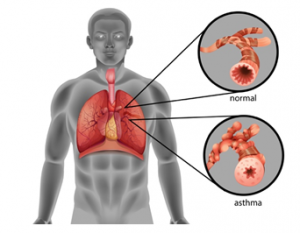
During an asthma attack, the bronchioles become swollen, go into spasm and fill with mucous. Asthmatics struggle for every breath, literally gasping and wheezing for life during an attack. In some the wheezing, gasping and struggling go on continuously and long-time sufferers may develop a barrel chest.
Asthma attacks may be triggered by allergic reactions, emotional stress, physical exertion or irritants like cigarette smoke. In the most dangerous form of asthma, status asthmaticus, the attacks last for days and can result in death.
Never A Fatal Disease
Asthma was never considered a fatal disease. Medical folk-wisdom always held that no child ever died of asthma. But now asthma kills thousands every year. It has changed.
And now it is the most common chronic condition in children.
Hurwitz EL, Morgenstern H. Effects of diphtheria-tetanus-pertussis or tetanus vaccination on allergies and allergy-related respiratory symptoms among children and adolescents in the United States. JMPT. 2000; 23:81-90.
Why has this happened?
It appears that the culprit is childhood vaccination. Research is increasingly revealing that asthma is exceedingly rare or non-existent in non-vaccinated children.
Pearce N et al. Is infant immunization a risk factor for childhood asthma or allergy? Epidemiology. 1997;8:678-680.
My family’s story seems to bear that out. I have three younger brothers. Myself and the twins who came after me never had asthma or food allergies growing up. However, David, our youngest brother, came down with asthma and allergies. Years later I asked him if he remembered when he first came down with asthma. “It was right after I got the measles shot,” he said. David’s three older brothers were spared the measles shot (it wasn’t offered when we were kids – I’m happy to report). By the way, David would later become an MD while this author became a chiropractor. Go figure.
The Standard Medical Approach – Causes
Medical researchers have proposed some bizarre theories bordering on the ridiculous such as blaming cockroaches, mice and our genes for asthma. Why ridiculous? Because cockroaches, mice and even our genes have been an unchanging part of our environment and lives for thousands of years. Therefore, they could not be the cause of a sudden, dramatic increase in asthma (or any other disease).

The Standard Medical Approach – Cure
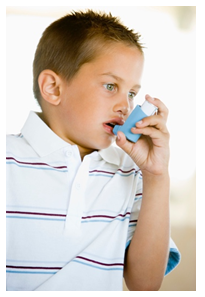 Medicine offers no cure for asthma, bronchitis or emphysema. Patients are told to avoid physical or emotional irritants and are given temporary relief with cortisone, inhaled corticosteroids or bronchodilators that prevent or reduce swelling inside the bronchi. These drugs may cause severe side effects including addiction. Heavy use of common asthma drugs has been linked to a greater risk of dying from the disease.
Medicine offers no cure for asthma, bronchitis or emphysema. Patients are told to avoid physical or emotional irritants and are given temporary relief with cortisone, inhaled corticosteroids or bronchodilators that prevent or reduce swelling inside the bronchi. These drugs may cause severe side effects including addiction. Heavy use of common asthma drugs has been linked to a greater risk of dying from the disease.
http://www.thedailybeast.com/is-advair-the-ultra-popular-asthma-drug-really-safe Retrieved September 27, 2017.
While offering temporary relief from symptoms, drug therapy is no cure for asthma and suppressing symptoms drives the disease deeper.
The Chiropractic Approach
For over a hundred years those suffering from all types of respiratory conditions have sung the praises of chiropractic care.
Leboeuf-Yde C, Pedersen EN, Bryner P et al. Self-reported non-musculoskeletal response to chiropractic intervention: a multination study. JMPT. 2005; 28:294-302.
A typical case history is that of a six-year-old girl with three years of uncontrolled asthma. She was taking a number of prescription drugs to control her symptoms. The patient experienced instant reduction in cough. In 30 days, no medication was being used. Upon subsequent visits to the pediatrician, the patient also demonstrated a marked increase in lung volume.
Fedorchuk C. Correction of subluxation and reduction of dysponesis in a 7-year-old child suffering from chronic cough and asthma: a case report. JVSR. November 26, 2007:1-5.
Another case is of a 23-month-old girl with severe asthma, gastrointestinal complaints and frequent colds. She was prescribed two antibiotics for digestive issues and an “array of asthma medications prescribed by her pediatric pulmonologist.” Subluxations were located and corrected in her neck, mid and lower spine with a 90% improvement of all problems; all medications were stopped.
Whittle-Davis H, Czegus K. Chiropractic care of a pediatric patient with asthma: a case report. J Pediatr Matern & Fam Health – Chiropr. 2011:3:77-81.
A 15-year-old boy with asthma and headaches began chiropractic care. He also complained of spinal pain, stiffness and muscle spasm. For eight years, he had been taking three to five medications per day plus using an inhaler as needed. Following the second adjustment he noticed improved breathing. He was off all medications after seven chiropractic adjustments. His other symptoms resolved as well.
Jaszewski E, Willard A. Resolution of asthma in a teenager following subluxation-based chiropractic management utilizing the Pierce Results System: a case study & selective review of the literature. J Pediatr Matern & Fam Health – Chiropr. September 5, 2016:87-91.
KST and Asthma
I have started all my patients this week with KST. One was an 8-year-old with asthma who has been a patient for two years. He has shown some improvement but he still has to use his inhaler and has had breathing treatments daily for the last three weeks. I corrected him with KST the Monday after the seminar. He has had no inhaler use or breathing problems for almost three days! The parents are VERY happy! H. Kala Eulitt, DC, Conroe, Texas
KST is a system derived from chiropractic and natural healing philosophy and procedures that explores the body/mind to locate and release stresses/blockages/interferences/subluxations whether they are physical (structural or toxicity) or mental/emotional or both.
KST procedures often find asthmatics have blockages in the upper neck/cranial and upper back/thoracic areas where nerves leaving from the spinal cord connect to the lungs, heart, bronchi, throat and neck. In some patients, the sternum (breastbone) and hyoid (found behind the chin) may be blocked, affecting the respiratory and cardiovascular systems. Other areas of stress/subluxation/blockage/interference may be found as well.
A patient with asthma came in to my office. She had been taking her inhaler all day but could barely speak. Using KST I addressed her lateral sternum…. I asked her to take a deep breath and to her surprise she was able to take her first full breath in days. I never would have checked the sternum without KST. Ken Liebman, DC, Colchester, Vermont
In addition to physical structural stresses we may find toxicity (possibly from vaccination) and emotional stress affecting asthma sufferers.
In Conclusion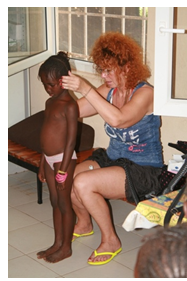
Everyone with asthma, bronchitis, emphysema, pneumonia or other respiratory (and cardiovascular) conditions needs to ensure their lungs, bronchi and heart are receiving unobstructed, uninterrupted communication with no blockages. Areas of toxicity as well as mental/emotional stress need to be addressed in order to have optimal health.
KST offers an exciting approach in quickly locating and correcting those stresses that interfere with our ability to reach our health potential.
Click here to learn more about KST.

Dr. Tedd Koren
Dr. Koren, originally from Brooklyn, NY, lives in Montgomery County, PA. A graduate of the U of Miami and Sherman College of Chiropractic, he writes, lectures and teaches in the US, Europe and Australia as well as takes care of patients and fights for healthcare freedom. Dr. Koren and his wife Beth have two children.

